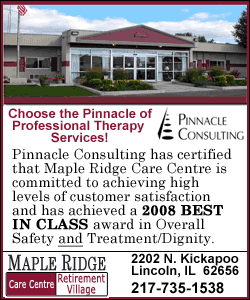 "If we do not feed our bodies good fuel, we will
not be able to optimally protect them," says Jennifer DiPasquale,
registered dietitian at Abraham Lincoln Memorial Hospital. "Our
immune system is under constant attack from pollutants, carcinogens,
contaminants, bacteria and viruses. In general, poorly fed people
tend to be sicker. " "If we do not feed our bodies good fuel, we will
not be able to optimally protect them," says Jennifer DiPasquale,
registered dietitian at Abraham Lincoln Memorial Hospital. "Our
immune system is under constant attack from pollutants, carcinogens,
contaminants, bacteria and viruses. In general, poorly fed people
tend to be sicker. "Diet has been linked to heart disease,
diabetes and throat, stomach, intestine and bowel issues, among
other problems. Nutrition advice is starting to catch up with that
message.
To mark National Nutrition Awareness Month, the HOPE Mobile will
offer handouts on nutritional information, including portion sizes
and making better choices while eating out. It will also provide
food diaries and instructions on how to use them. The HOPE Mobile's
monthly schedule is available at
www.healthycommunitiespartnership.org
/index_files/schedule.htm.

For decades, nutrition advice has focused on what foods to avoid,
leading Americans to be overweight but undernourished, according to
the American Dietetic Association. Today the emphasis has become the
total nutrient package instead of just focusing on the saturated
fat, sugar and salt content of choices.
The ADA says nutrient-rich foods are
familiar, easy to find and represent the basic five food groups:
-
Brightly colored
fruits -- preferred over 100 percent fruit juice.
-
Vibrantly colored
vegetables and potatoes.
-
Whole, fortified
and fiber-rich grain foods.
-
Low-fat and
fat-free milk, cheese and yogurt.
-
Lean meats, poultry, fish, eggs, beans
and nuts.
"Almost everyone underestimates the amount of food eaten,"
DiPasquale says. "Media and marketing have led us to believe that
large and even huge portions of high-calorie and high unhealthy fat
foods are normal and acceptable. We need to retrain our brains, get
out the measuring cups and look at serving sizes according to
healthy guidelines."
She also says to compare packaging with labels, as some packages
appear to be a single serving but are not.
[to top of second column] |

It's also OK, DiPasquale says, to question how a dish is prepared
when eating out. "Surprisingly, a red pasta sauce made with an oil
base can have as many if not more calories than a white flour base
sauce, ” she said. “Same
thing goes for steamed broccoli drenched in garlic butter versus a
small baked potato or other starchy vegetable. "
A few tips that you can start using
today, according to DiPasquale and the American Dietetic
Association:
-
Calorie counting
can still be very useful for most people.
-
Snack on canned
fruit in water or light syrup, raw carrots, whole wheat bread
with a thin layer of peanut butter, a handful of high-fiber
cereal.
-
Switch to
whole-wheat pastas.
-
Cut and bag
veggies for ready-to-eat snacks.
-
Share an entree
with a friend when eating out.
-
For dessert, blend fruit, low-fat milk,
ice and a splash of pineapple juice, or stir chocolate syrup
into a cup of coffee-flavored yogurt and freeze for later.
The HOPE Mobile is a component of the Healthy Communities
Partnership, a collaborative organization comprised of dozens of
community agencies. It is supported in part by the Abraham Lincoln
Healthcare Foundation.
[Text from file received from
Healthy
Communities Partnership]

|